LUCIFER BEFORE SUNRISE
(Vol. 14, A Chronicle of Ancient Sunlight)
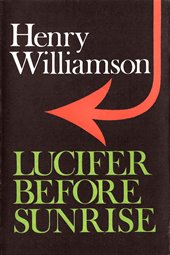 |
|
| First edition, Macdonald, 1967 | |
Book Two: The Malevolent Glint
Appendix: Epigraphs – some background
First published Macdonald, 26 October 1967 (35/-)
Macdonald, reprint 1985
Sutton Publishing, paperback, 1999
Currently available at Faber Finds
Title page epigraphs:
'If a poet is sensitive enough to his age and brave enough to face it directly, it will kill him through exacerbation of his senses alone.'
Author unknown
‘If way to the better there be, it enacts a full look at the worst.’
Thomas Hardy
(All epigraphs are further examined in the Appendix.)
Dedicated:
To
Father Brocard Sewell
O. Carm., R.A.F. (retired), etc.,
of Aylesford Priory, Kent.
Father Brocard Sewell (born Michael Seymour, 1912‒April 2000) had been a friend and supporter of HW's work since the mid-1950s. He had been apprenticed in the 1920s to Hilary Pepler (founder of the St Dominic's Press and co-founder with Eric Gill of the Ditchling Press), and later worked at other private printing presses. During the Second World War Seymour served with the RAF as an administrative clerk and afterwards prepared to take Holy Orders; he was ordained into the Order of Carmelites at the newly refurbished Aylesford Priory in 1952, taking the name of Brocard Sewell. In 1955 he established The Aylesford Review as a journal for laymen, but quickly incorporated a literary aspect and widened its circulation.
The 1957/58 Winter Issue (Vol. II, No. 2) was devoted to HW; it was subtitled: ‘Henry Williamson: a Symposium and Tribute’ and included a fairly comprehensive coverage of the full range of HW's work. The essays included:
'Henry Williamson': Editorial by Fr Brocard Sewell, pp 33-7
'Williamson, the London Novels', W. Gore Allen, pp. 37-41
'Henry Williamson, an English Proust', Malcolm Elwin, pp 42-8
'The Novels of Henry Williamson', John Middleton Murry, pp 49-55
'Some Notes on the Flax of Dream and A Chronicle of Ancient Sunlight', HW, pp 56-61

Ensuing issues of the Aylesford Review also contained articles about or by HW.
HW was very grateful for Fr Brocard's support and the dedication here was to show his appreciation. The two men had a lengthy correspondence (now lodged with the HW Society Archive at Exeter University), which contains a great deal of information about the Chronicle of Ancient Sunlight novels and HW's personal life. HW attended several 'Literary Meetings' at Spode House where he met a group of young aspiring poets and writers who tended to lionise him, which he greatly enjoyed, especially when life was difficult.
For more information regarding Fr Brocard and HW’s involvement with the Aylesford Review’s literary activities, see the Appendices to the In the Woods entry and Fr Brocard’s memoir ‘Some Memories of H.W.’.
After HW's death Fr Brocard organised and edited a symposium of essays of insight into HW's life and writings: Henry Williamson: The Man, The Writings (Tabb House, 1980, now available solely through the HWS).
Fr Brocard was also a Vice-President of the HW Society from its inception in 1980 until his own death in 2000. He also contributed an article on ‘The Aylesford Review’ to the Society’s journal (HWSJ 5, May 1982, pp. 23-9), which includes a ‘Checklist of HW articles in The Aylesford Review.
HW's intense emotional state at this time over his relationship with Ann Quin and the contretemps as she left for Greece on 30 June 1964 has already been noted in the entry for A Solitary War. Here we continue with details pertinent to Lucifer before Sunrise.
Mention has already been made too of the existence of three quarto notebooks containing the manuscript entitled 'A Norfolk Farm in War-time', ostensibly a journal kept during the war years (but already to some extent in novelised form), and typed up at the end of the Second World War. This had been put aside, as HW was advised to hold the material until its proper place in the actual Chronicle series. That was probably the soundest advice that HW was ever given. To have started with the farm era would have been confusing to say the least.
It should be noted that sections of the original material had already been printed as articles. First, in The Adelphi:
i) Vol. 22, No. 4, July – Sept. 1946: 'Farming Story'
ii) Vol. 23, No. 2, Jan – March 1947: 'From “A Wartime Norfolk Journal”: Easter 1944'
iii) Vol. 24, No. 2, Jan – March 1948: 'From “A Chronicle Writ in Darkness”' (Christmas 1941)
And second, in The European:
i) No. 7, Sept. 1953: 'from A CHRONICLE WRIT IN DARKNESS' (I)
ii) No. 8, Oct. 1953: 'from A CHRONICLE WRIT IN DARKNESS' (II)
iii) No. 35, Jan 1956: 'from A CHRONICLE WRIT IN DARKNESS' (III)
The first mention of the actual writing of Lucifer before Sunrise (hereafter Lucifer) occurs in his diary on 9 July 1964:
I went to lunch with E.W. Martin at Black Torrington & collected my caseful of Lucifer mss.
HW then went on to North Tawton to visit first:
Olwyn Hughes (Ted Hughes' sister) for tea & the Hughes for supper. And stayed talking until 1.30 a.m. . . .
Then, fearing he was nearly out of petrol, he stopped at a garage in the middle of the night and waited until they opened the next morning, dozing in the car, finally getting home:
at 7.30 am & went to bed. Later worked on revising or adjusting Lucifer to Phillip M.
HW had first left this material – together with further typescript versions made in the mid-1950s – with Ernie Martin on 22 May 1963 (when he was still in a state of shock over Christine, his second wife, leaving him just before Christmas 1962), referring to it as his 'Lucifer' material: asking Martin to annotate and index it all so that he could find his way around it easily for details.
HW had then collected the 'Lucifer' material from Ernie Martin on 4 November 1963 – 'expertly analysed and indexed'. However he was soon complaining in his diary that Ernie's annotations were not thorough or sufficient for his purpose. And he must have returned it all at some point as he notes collecting it again on 9 July 1964 as above.
On 11 July he noted working at the Field on No. 13 (A Solitary War) then:
Monday, 13 July 1964: To dine with Christine. Read some of No. 14 to her – it sounded good against her receptivity.
Tuesday, 14 July: Wrote all day, recasting Lucifer Before Sunrise (14). Worried about A.Q.
Earlier that week he had also been revising No. 12 (The Phoenix Generation), so he was working on volumes 12, 13, and 14 all at the same time! That is of course understandable, as all are concerned with the Norfolk Farm era.
17 July: E.W. Martin's 'Index' of the Lucifer variations is useless [this entry continues with considerable detail].
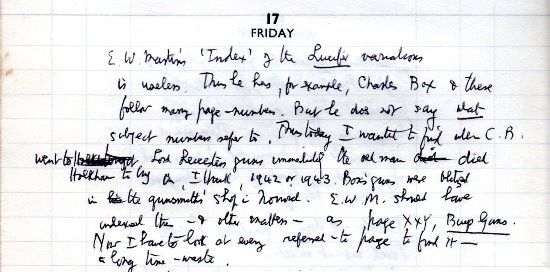

19 July: Despondent. Working hard on Lucifer. Ernie Martin work on Lucifer practically of no use to me. Muddled about Lucifer. I can't hold to mind what I have written.
Some of this state of mind was due to having received 'no letter from A.Q.': to recap – Ann had left for Greece (Corfu) in a hysterical state following HW's announcement that he had caught a venereal disease from her (mistakenly; he hadn’t). A few days later HW noted that he wrote to 'E.W. Martin' saying that he couldn't cooperate on a proposed book on himself that Ernie was apparently planning. Apart from the fact that HW was in the throes of writing the Chronicle, and that any such project would have been a huge interruption, he had realised that he and Ernie could not work together. He had of course paid Ernie for undertaking the annotation work.
22 July: I am near the end of Lucifer Before Sunrise – working, & smoking, all day.
The next day he first worked on Lucifer, and then was involved in a complicated arrangement to collect his son Harry's bike and trunk from Millfield School, take them back up to Christine at Stuckeridge, and then drive down to Cornwall to be with his daughter Margaret, his first wife Gipsy, and younger daughter Sarah, all staying at St Mawgan on holiday. (Margaret had just left her first husband, the artist Bill Thomson, and planned to marry Julian Bream, the guitarist and lutenist.)
24 July: Wrote most of the day & finished Phillip's own story of his East Anglia farming venture at 11.30 pm at night.
HW enjoyed this break (there was a female friend of Margaret's there to whom he paid and received attention!) in the company of 'Joanna'; he took her to the Field at Ox’s Cross on 31 July, and she returned to London on Sunday 2 August. On which day:
My article had first place in Sunday Times Magazine with 1915 photography. 'The Last Summer of the Old World' (£100).
This was to mark the fiftieth anniversary of the outbreak of the First World War. He had already had a series of five articles, 'Return to Hell', published in the Evening Standard (reprinted in the 1987 Gliddon edition of The Wet Flanders Plain). Both ‘The Last Summer’ and ‘Return to Hell’ are posted on this website.
On 8 August there is another entry about Ernie Martin:
I find I am worrying about E.W. Martin's blind-spot indexing of the details in the various versions of Lucifer . . . his ‘research’, over the months he worked on the various versions is almost entirely without use to me. I want to know what I omitted in the final smoothed-down 'killed' version. . . . It's senseless of me to give an unbalanced bowdlerised version – the effect of the narrator without all the causes.
On 9 August 1964 HW spoke at the British Legion Memorial Service (for the fiftieth anniversary commemoration), reading his 'Apologia pro Vita Mea' from The Wet Flanders Plain, and also poems of Julian Grenfell and Wilfred Owen. The next two days he worked on the last part of No. 12. His overall work load was tremendous. Further, since 29 July the artist Barry Driscoll and his wife had been staying at the Field, leaving on 19 August (there is no mention of them in HW’s diary in between those two dates!). Driscoll (1926‒2006) illustrated the Nonesuch edition of Tarka the Otter, published in 1964.
On 15 August HW got rather upset about a letter from a woman asking if her son could come for a visit, to walk and enjoy the beauties of nature in his company, apparently suggested by Brocard Sewell. For HW this was:
the last straw of the back-breaking load. I am hollow & hopeless, unable to tackle Lucifer owing to E.W. Martin's useless work on Lucifer and almost overwhelmed.
There follows some scrawled but detailed notes of queries of points he wants to make; but on 17 August he was back working on No. 12, and this was now his main writing concern (including the revision he and I did together) until almost the end of the year. But also from this time HW became involved with Sue Gibson, yet another turbulent relationship. Having given her and her friend a lift and taken them back to the Field for tea, Sue Gibson became his latest dame d'amour. She offered to do paid typing for him (as noted in the entry for A Solitary War), but, although initially enthusiastic about her 'beautiful' typing, HW rapidly discovered she was not reliable, not returning (precious) material, and causing him considerable angst. His emotions were further disturbed with the return of Ann Quin from her Greek sojourn, once again becoming involved with her.
On 13 December he resumed work on Nos. 13 and 14, noting on the 17th that he continued 'writing, or recasting of, 13 & 14' but the rest of the month is blank. He noted on 24 January 1965: 'Writing Lucifer'; but there is no further mention of the book until after the presentation of his 'Devon manuscripts' to Exeter University on 14 May. On 21 May he visited his erstwhile typist Elizabeth Tippett (now married and Mrs Cummins) in Cornwall to take: 'No 14 Mss-Tss (Lucifer) & collect No. 13 . . .', and on 29 July he went down again to collect it.
At the end of September 1965 there is the note on two consecutive pages about a quotation he wanted to use in the book, but no further mention of Lucifer for the remainder of the year, although HW does occasionally note working on the final preparations for A Solitary War. The Phoenix Generation was published on 28 October. Throughout this period the see-saw relationship with Sue Gibson continued.
26 January 1966: [after several entries trying to 'explain' Sue Gibson'] Harry telephoned to say he & Christine were coming over as he wanted his mother's record player, which I had repaired for her (£1/12/6) as a present. They came – I am in middle of rewriting Doppelganger (Chapter 27) of Lucifer; & [they] left at 7.20 p.m.
Next: in early February HW added a note about quotations he planned to use as epigraphs on the title page:

In the end the Dag Hammarskjöld phrase was placed later within the text (see Appendix). It is not clear which Hitler phrase he is referring to here. But what is clear is that HW wanted to give what he felt was a balanced view: to show that Germany was not entirely and solely to blame for the war.
There was now a diversion over a small contretemps about the Disney film Flash, the Teenage Otter. A friend saw the film and tipped him off that it appeared to be a plagiarism of Tarka the Otter. He saw the film, noted that several scenes seemed very derivative, and visited his lawyer. However he was advised that it would be very difficult to prove such a case, especially against such a huge corporation as Disney. And, somewhat to his relief, the idea was dropped: it would have been a huge interruption to his work. Also at this point Sue Gibson finally told him that she was in fact lesbian, which he had suspected for some time. However, he had just met two sisters, Jacqueline and Madeleine Gallard, and so diverted his attention and emotions on to them.
25 April: I am tempted to break my book – which isn't flowing yet, since the break at Bristol for Slimbridge, to go to a party in London – but it will be too tiring to stay up til early hours of the morning.
The visit to Bristol/Slimbridge (Peter Scott's home) had taken place over the previous weekend. HW stayed on 23 April with John Irving, a BBC Producer:
To be at 10.30 am at Slimbridge, the Queen & Peter Scott.
Cheque for two luncheons sent 5/4/66.
Slimbridge was (and still is) the main centre of Scott's 'Wildfowl Trust'; presumably Her Majesty the Queen made a visit.
HW was using up a great deal of nervous energy rushing around hither and thither: back and forth to London quite often with regard to Sue Gibson, Frances Horovitz, and the Gallard girls, and to other commitments elsewhere. And he did of course go to the London party!
Sunday, 8 May: My BBC T.V. programme – 'The Survivor'. Saw it with Christine at Ilfracombe.
The Survivor, an impressive film made by the distinguished director Patrick Garland, features HW throughout, in a tour de force, as he tells his life story. Maurice Wiggin, in his Sunday Times review of the programme, wrote:
To millions, Henry Williamson’s name means the peace of the countryside; yet, as Patrick Garland established in his vivacious, perceptive and sympathetic ‘exploration’, The Survivor, Henry’s life and thought have not been simply dominated, but obsessed and ravaged by war. Cursed with total recall, helpless victim of merciless memory, my dear and honoured friend is still fighting; still, at seventy, expiating the subjective crime of having survived . . . I thought it a revealing and rounded portrait of the whole man, the best I have seen of that complex and elusive being.
At the beginning of June HW noted that he was dealing with proofs of A Solitary War, and also making notes for 'Somme' articles for the Daily Express. This long major article 'The Somme – Just Fifty Years After' appeared in three parts daily from 29 June (it has been reprinted in Days of Wonder, ed. John Gregory, HWS, 1987; e-book 2013).
But any peace of mind, or sense of satisfaction, he might have then been experiencing due to these events was totally shattered at the end of August by Christine's sudden and complete breakdown. HW was much concerned and involved in dealing with this over a period of months. But on 11 September 1966, in the middle of all this, he noted:
S. Sassoon's 80th birthday BBC Home. 10.10 p.m. (HW takes part)
Also that day he posted ‘103 pp to E.M. Cummins [Elizabeth Tippett that was] for retyping of 14’.
11 November: I motored 160 miles to collect TSS from E.M. Cummins, then to Beaford to meet Jennie Lee, Minister of Arts etc.
But unfortunately he does not give the reason for this meeting!
During November a lady named as Patricia King came to type daily, from 9 a.m. to 1 p.m. at £5 a week; this being Lucifer. On 2 December he noted: ‘To hand over Ts of Lucifer to Pat King for final reading.’
On 8 December HW was to have visited London to meet his 'Trustees' (i.e. his sons) as he had planned a Trust to look after the Field and property at Ox's Cross after his death (he was then just 71). This proposal was to cause a great many problems over the next few years! But he also noted:
Take Tss of Lucifer to Macdonald. — [Crossed out and 'Not ready' added instead].
In mid-January 1967 he entered into his diary on two days running (18th and 19th), details of an accident that he had experienced on his way to London: 'ACCIDENT AT 6.35'
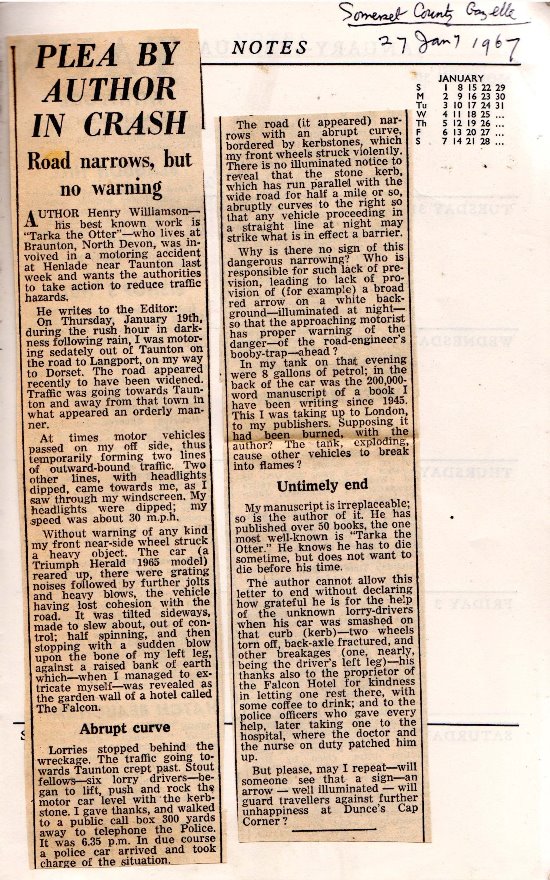
Despite what this letter states, the accident was almost certainly on Wednesday, 18 January. HW was due at a PEN meeting the next day, dining first at the Chelsea Arts Club. He could never have got from Devon to London in time if he had left it until that time on the 19th.
On Monday, 23 January 1967 he noted: 'Revising/reading TSS of 15 at Nat. Lib. Club.’ [This has to be an error for No. 14.]
25 January: Handed over Tss of Lucifer to Foster White of Macdonald & Co.
On 27 January he returned to Devon by 'Train, Taxi; & bus'.
In early April 1967 Margot Wall (née Renshaw – 'Melissa' in the Chronicle) had returned to England from South Africa where she had been living since her marriage in September 1945, and was ensconced at a course in Scientology run by Ron Hubbard, supposedly for three weeks. She was still there at the end of July. She and HW took up their former friendship where it had left off some years previously. This is mentioned here as HW weaves her into this Lucifer, while she becomes an important component of the fifteenth and final volume of the Chronicle.
12 June: Mrs. Elizabeth Compton to arrive at Field with proofs of Lucifer. (Proofs left at Barnstaple.) [There is no explanation for this – perhaps the parcel came by rail and this lady delivered them to HW?]
13 June: Proof reading.
The proofs were sent back the next day.
17 October: DIVORCE (alas!) v. C.M.W. I was given a decree nisi.
26 October: Lucifer published.
*************************
Lucifer Before Sunrise is a long and complex book with just under 500 actual printed pages (the pagination is 515, but the story itself only starts at p. 15 and includes several blank pages marking 'Parts' etc.) and is at least 252,000 words – indeed, the longest volume in the series. To do it justice, this analysis must necessarily be quite detailed.
Interestingly HW made the following note in the front of his file copy:
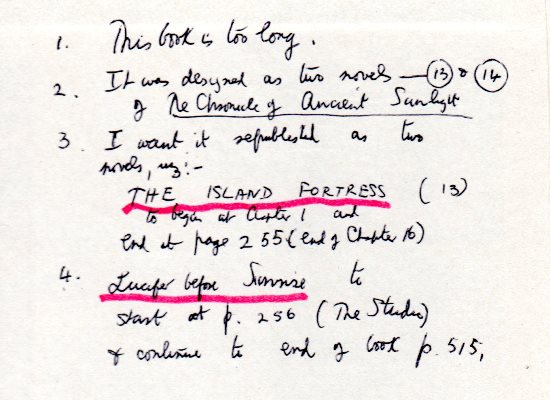
(However he has made an error there: volume 13 was already published!)
He also noted here a short list of misprints, including wrong spelling for 'Hammarskjöld' and 'Callander', and a couple of small corrections.
Although long, the book is full of interest and engrossing details, capturing the frustrations and difficulties of life on the farm during the Second World War, balanced by charming episodes and lyrical descriptions of nature. Together with an underlying 'continuo' of the war, mainly shown through the constant noise and sight of bombers and fighters on their way to and returning from missions, it gives a full picture of life in that particular era.
A list of the contents is reproduced here as an aid to, and reference for, understanding the complex structure.
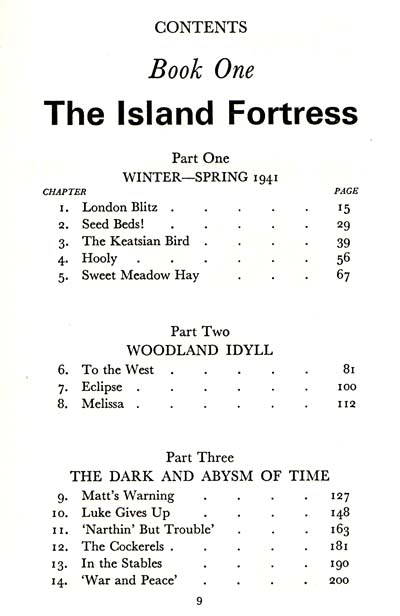
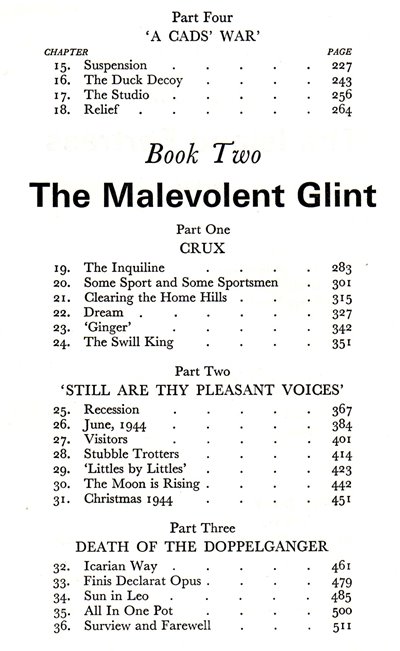
(The heavy typeface used gives it a rather startling and dramatic appearance. It would be interesting to know how this evolved: HW or the printer?)
Nearly every part and sub-division has its own epigraph as a heading, adding to the complexity – or rather, the underlying message – of the plot. These are of interest as a sub-plot for the researcher, but readers should not let them hinder the flow of the story itself: which basically continues the life of Phillip Maddison on the Norfolk Farm during the period of the Second World War. To avoid disruption these quotations are analysed in a separate Appendix.
It should also be noted that although HW moves actual real-life events around within the novel structure to give more coherence to his overall story, most of the incidents did in fact actually happen more or less as recorded here.
Throughout this volume there are entries as if from Phillip's diary: such entries are in the main lifted directly from HW's original journal MSS in three volumes (a fourth volume is not present – and perhaps was never finished), 'A Norfolk Farmer in War-Time' (otherwise named 'A Chronicle Writ in Darkness') which, although ostensibly a journal, was already fictionalised and written as a story in itself. This work, as previously noted, was intended to be the sequel to The Story of a Norfolk Farm.
For ease of navigation, my consideration of the two parts of the book are given their own pages:
Book Two: The Malevolent Glint
*************************
Index to Lucifer before Sunrise
Between 2000 and 2002 Peter Lewis, a longstanding and dedicated member of The Henry Williamson Society, researched and prepared indices of the individual books in the Chronicle of Ancient Sunlight series (the first three volumes being indexed together). Originally typed by hand, copies were given only to a select few. His index to Lucifer before Sunrise is reproduced here in non-searchable PDF format, with his kind permission. It forms a valuable and, indeed, unique resource. The synopsis (with Peter Lewis's delightfully idiosyncratic asides) is not included, as essentially it repeats information already given in the consideration above.
*************************
Click on link to go to Critical reception.
*************************
The dust wrapper of the first edition, Macdonald, 1965, designed by James Broom Lynne:
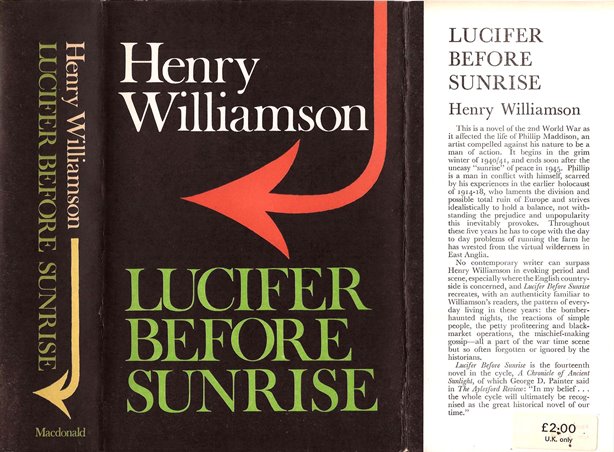
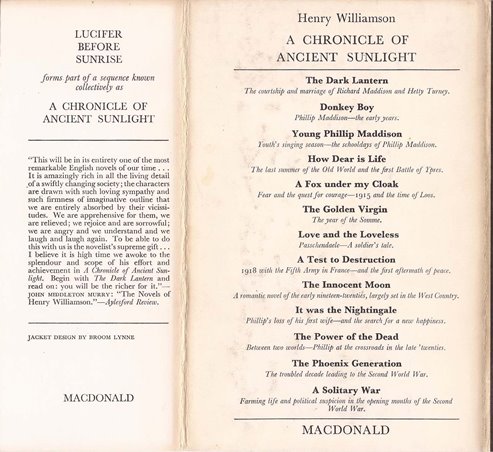
Other editions:
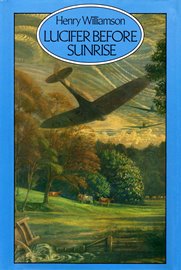 |
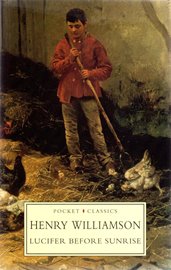 |
|
| Macdonald, hardback, 1985 | Sutton, paperback 1999 |
Back to 'A Life's Work' Back to 'A Solitary War' Forward to 'The Gale of the World'
